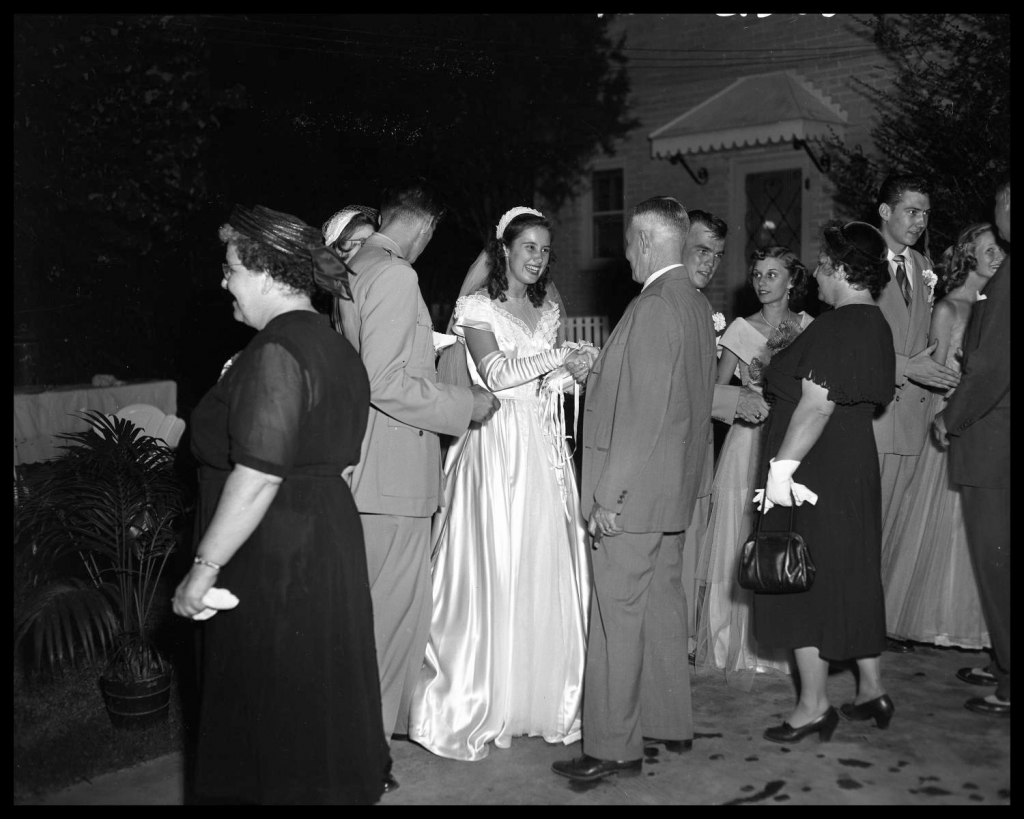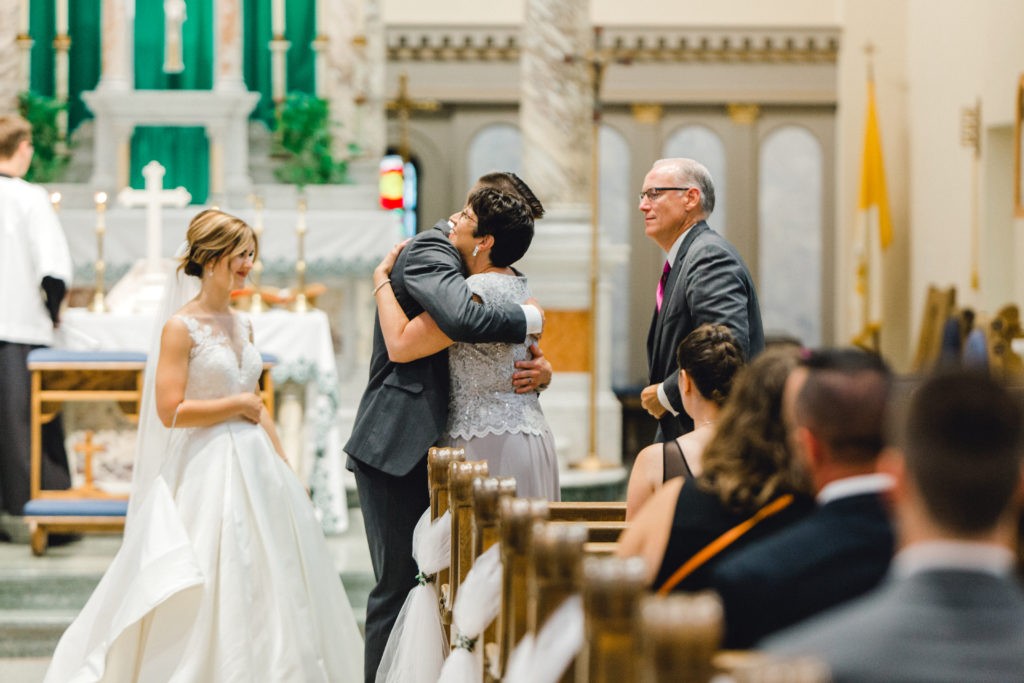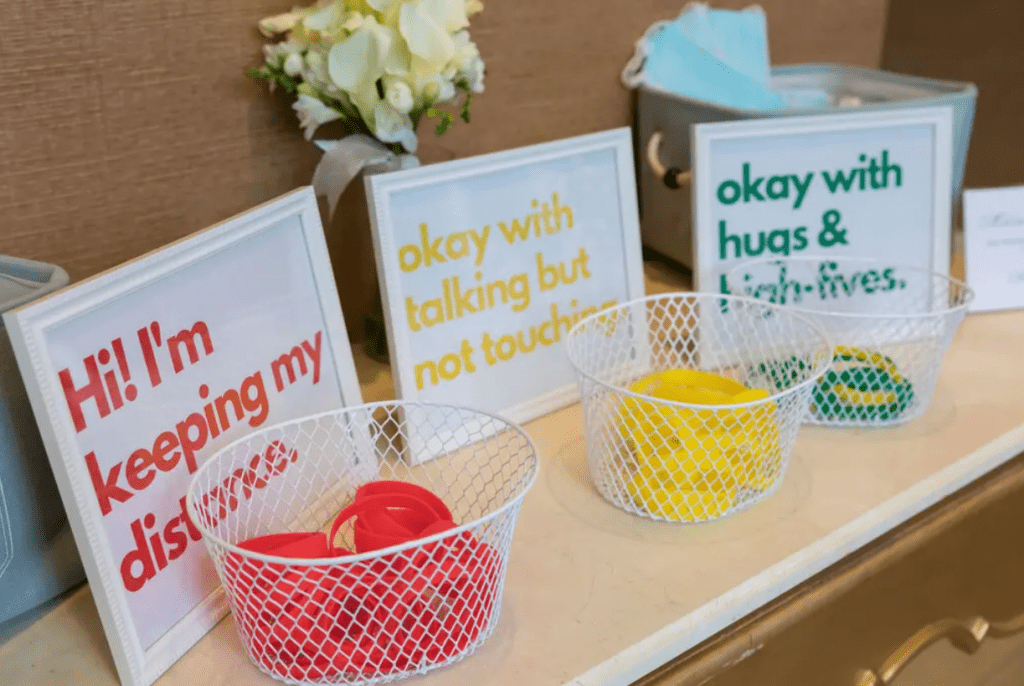A Full Guide to Organizing a Wedding Receiving Line
The wedding day is by far the most anticipated day of everyone’s life, yet the most complicated one to plan. Planning a wedding can be, at times, a very stressful occasion. There are so many details that need to be perfect, and one of them is the wedding receiving line.
Wondering what it is and how to plan it perfectly?
I’m going to tackle all the questions related to this tradition from A to Z. Let’s dive right in.
Table of Content
What Is a Wedding Receiving Line?
A wedding receiving line is when the bride, groom, and their parents stand in line to meet their guests individually. This is the best part of the wedding when you can personally greet and talk to each and every guest.
In the below image, you can see what a traditional receiving line looks like.

Some people may have come from a long distance, and there may be some relatives you haven’t seen for ages, and they made an effort to arrive at your wedding, so the best way to manage to meet all of them is through a receiving line.
During this tradition, the wedding guests stand up in a queue to meet the bride and groom. This way, each guest has the chance to congratulate the couple in person and exchange a few words.
When Is the Right Time for the Receiving Line?
Usually, wedding receiving lines take place right after the ceremony. If we wind back the time, initially, receiving lines used to take place before the reception. This tradition first appeared after WWII when people started celebrating bigger weddings at venues.
Nowadays, couples can choose the right time to have a receiving line individually. But in general, the most comfortable timing is to do the receiving line at church right after the ceremony of exchanging wedding rings, as portrayed in the image below.

If you have an open-air ceremony, you can have the receiving line outdoors. Couples can walk down the aisle and wait for the guests to line up and greet them. Also, you can have the receiving line at the reception. In this case, the bride and groom need to arrive earlier at the venue before the guests.
However, doing a receiving line before the reception can be pretty tiring, especially when you have a long guest list. But if you have guests that couldn’t make it to the ceremony and would arrive directly at the venue, it’s better to have the receiving line at the reception.
How to Set Up the Receiving Line?
According to Emily Post wedding etiquette specialists, the bride and the groom, alongside their parents, should take part in the wedding receiving line. Often, the chief bridesmaid and the best man participate too.
However, there’s a tricky situation when the parents are divorced. In this case, it all depends on your relationship with them and whether they get along together or not. If the divorced parents are not in a good relationship, the wisest decision would be not to include them in the receiving line.
There are three main types of wedding receiving lines, which I’m going to break down below.
- Traditional receiving line. In this case, the newlyweds stand at the back of the venue and greet everyone as they leave.
- Cocktail hour receiving line. If you choose this format, you need to leave the ceremony, head right to the cocktail hour’s space, grab yourself a drink and wait at the door to greet everyone as they arrive. However, in this case, you need to reschedule your photoshoot, which usually takes place right after the ceremony.
- Dinner receiving line. This option is quite different from the above options since guests don’t stand in line to greet you. Instead, you approach every table during dinner. However, if you have a large guest list, I don’t recommend picking this option; otherwise, you and your spouse won’t have time to eat dinner at your own wedding.
When you have more than 100 guests, the best way out is to include only the newlyweds in the receiving line. The parents aren’t the stars of the show, so it’s not necessary to include them. However, I highly recommend you discuss this with them before making such a decision.
How Long Does the Receiving Line Part Last?
The duration depends on the number of guests present at your wedding, as well as the length of the entire wedding. Usually, wedding receiving lines can last from 30 minutes up to an hour.
According to bridal forums, you need to spend around 20 seconds with each guest. So, when you have 100 guests, your wedding receiving line should last about 30 to 40 minutes.
What to Say at a Wedding Receiving Line?
The wedding receiving line is stressful not only for the bride and groom but for guests as well. I’m sure many of us have been in this situation where you can’t find the right words to say to the newlyweds during the receiving line.
So what should we say?
First of all, you need to remember that you don’t have much time to speak, as you have around 20-30 seconds. So, you need to keep it short.
The best thing you can say is what comes from your heart, your pure wishes to the newlyweds. If you know only the bride or the groom, you can start by introducing yourself, then continue your speech.
Furthermore, you can thank the couple for the invitation and compliment the wedding ceremony and venue decoration.
So, let’s sum up. Introduce yourself, thank the couple for the invitation, and congratulate them on their important day. This should be more than enough for a short wedding receiving line speech.
Wedding Receiving Line Alternatives
Modern couples may look for alternatives to the traditional wedding receiving line.
One of them is holding a pre-wedding welcome party. If you’re drifting away from formalities, this receiving line alternative is the best option. To save some time during the big day, you can have a pre-wedding party a few days earlier. You can go with a casual brunch or a cocktail party with your guests, where you’ll have enough time to talk to all of them.
Another alternative is to entertain your guests during the receiving line. Oftentimes, during large weddings, receiving lines can last around an hour or even more, and it can be quite tiring and sometimes even boring for the guests who have to wait for so long.
However, you can entertain the attendees by asking the staff to serve them cocktails and snacks. Another option is to have your guestbook where guests can write wedding wishes.
This last option can be quite risky during times of pandemic. As an alternative, below, I’ve selected some planning tips for maintaining safety measures at the receiving line.
Important – Organizing Receiving Lines During the Pandemic
The COVID pandemic is not over yet, so you need to consider safety measures during the receiving line. Traditionally, hugs, kisses, and handshakes were part of the ceremony, but today we have to look for alternatives.
If you’re going to follow safety measures at your receiving line, you can inform your guests about the rules beforehand or have informational signs throughout the venue. This way, the guests will know what type of greeting you prefer.
Here are some alternative greeting options to use at receiving lines during the pandemic.
- Foot shakes or elbow bumps instead of a handshake. Since the pandemic hit, it’s becoming more and more common to greet people with elbow bumps or foot shakes. This is a fun way to welcome your guests without touching or getting too close to them.
- Classic bows. This gesture comes from the Asian culture, and you can use it to greet guests at your receiving line. This way, you can stay completely contactless while maintaining a safe distance. With bows, you not only salute your guests but also show your respect and gratitude.
- Colored wristbands. This one’s my favorite alternative. You may have seen weddings that use colored wristbands during the pandemic. Each color includes a message, and guests decide which one they prefer.

Accordingly, one of the bracelets means that the guest is okay with hugs, the next indicates that they’re keeping their distance, and the last option means that they’re okay with talking only.
I think this is the perfect format as it provides your guests with the freedom of choice and doesn’t seem pushy.
Over to You
Wrapping up the article, I’d like to say that it’s crucial to schedule your wedding receiving line to be planned to the tee. It’s your big day, and you’re in charge of everything.
You can go with wedding traditions and have your parents with you to take part in the receiving line at church. Or you can go with the earlier-mentioned alternatives.
I hope my tips will help you with your wedding preparation.
Looking for more wedding planning articles? Follow my blog, where I constantly publish articles on weddings, beauty, lifestyle, and beyond.










